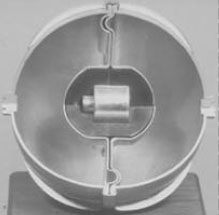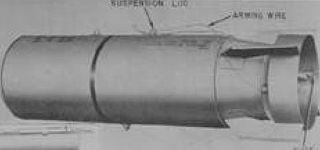
The M125 bomblet was a U.S. chemical sub-munition designed to deliver the nerve agent sarin. It was brought into service in 1954 with the M34 cluster bomb as part of the first U.S. air-delivered nerve agent weapon.

The M125 bomblet was a U.S. chemical sub-munition designed to deliver the nerve agent sarin. It was brought into service in 1954 with the M34 cluster bomb as part of the first U.S. air-delivered nerve agent weapon.
The M125 bomblet was a sub-munition of the M34 cluster bomb, which was first brought into regular service by the United States Army in 1954. [1] In development the M125 was known as the E54R6 bomblet (shortened to E54). [2] The M34 and its payload of M125s was the first air-delivered nerve agent weapon in the U.S. chemical arsenal. [2] Later, the Chemical Corps developed chemical-biological warheads for multiple missile systems including, Matador, Rascal, Snark, and Navaho missiles. [2] These warheads incorporated the M125 bomblet and the M114 bomblet. [2] Over 21,000 of the M125 containing M34 bombs were destroyed at Rocky Mountain Arsenal in 1976. [3]
The M34 was designed to hold 76 M125 bomblets, [1] arranged in four groups of 19. [3] Each bomblet held 2.6 pounds (1.2 kg) of the nerve agent sarin, and 8.8 ounces (250 g) of the explosive tetryl. [3] The ten pound cylindrical M125 bomblet also held an opening delay, fuze and parachute, as well as a burster, which contained the explosive. [3] A M34 cluster bomb, fully loaded with M125 bomblets, had an agent weight to weapon weight ratio of 17 percent; the M34 and M125 were not the best delivery system. [2] Eventually, cylindrical chemical bomblets, such as the M125, were supplanted by spherical models because they could obtain a greater coverage area. [2]

A warhead is the forward section of a device that contains the explosive agent or toxic material that is delivered by a missile, rocket, torpedo, or bomb.

Chemical warfare (CW) involves using the toxic properties of chemical substances as weapons. This type of warfare is distinct from nuclear warfare, biological warfare and radiological warfare, which together make up CBRN, the military acronym for chemical, biological, radiological, and nuclear, all of which are considered "weapons of mass destruction" (WMDs), a term that contrasts with conventional weapons.

The United States is known to have possessed three types of weapons of mass destruction: nuclear weapons, chemical weapons, and biological weapons. The U.S. is the only country to have used nuclear weapons on another country, when it detonated two atomic bombs over two Japanese cities of Hiroshima and Nagasaki during World War II. It had secretly developed the earliest form of the atomic weapon during the 1940s under the title "Manhattan Project". The United States pioneered the development of both the nuclear fission and hydrogen bombs. It was the world's first and only nuclear power for four years, from 1945 until 1949, when the Soviet Union produced its own nuclear weapon. The United States has the second-largest number of nuclear weapons in the world, after the Russian Federation.

The M55 rocket was a chemical weapon developed by the United States in the 1950s. The United States Army produced both Sarin and VX unitary warheads for the M55.

The M139 bomblet was an American sub-munition designed for use in warheads as a chemical cluster munition. Each spherical bomblet held 590 grams (1.3 lb) of sarin nerve agent.

The E120 bomblet was a biological cluster bomb sub-munition developed to disseminate a liquid biological agent. The E120 was developed by the United States in the early 1960s.
The M143 bomblet was a biological cluster bomb sub-munition developed by the United States during the 1960s. The spherical bomblet was the biological version of the Sarin-filled M139 chemical bomblet.

The M33 cluster bomb, also known as the (M33) Brucella cluster bomb, was a U.S. biological cluster bomb developed in the early 1950s and deployed in 1952. It was the first standardized biological weapon in the U.S. arsenal.

The M114 bomb was a four-pound U.S. anti-personnel bomb and biological cluster bomb sub-munition. The M114 was used in the M33 cluster bomb.

The Flettner rotor bomblet was a U.S. biological sub-munition that was never mass-produced. Based on the vertical Flettner rotor which takes advantage of the Magnus effect, a force acting on a spinning body in a moving airstream, it was developed toward the end of the U.S. biological weapons program in the 1960s.

The M34 cluster bomb was the first mass-produced United States Army weapon meant to deliver the chemical agent sarin (GB). A large stockpile of M34s was destroyed between 1973 and 1976.

The M43 BZ cluster bomb, or simply M43 cluster bomb, was a U.S. chemical cluster bomb intended to deliver the incapacitating agent known as BZ. The weapon was produced in the early 1960s and all stocks of U.S. BZ were destroyed by 1989.
The M138 bomblet was a sub-munition of the U.S. chemical weapon, the M43 BZ cluster bomb. The bomblet contained BZ, an incapacitating agent and was developed with the M43 in 1962. The M138s, along with all other U.S. BZ weapons were destroyed during the 1980s.

The M44 generator cluster was an American chemical cluster bomb designed to deliver the incapacitating agent BZ. It was first mass-produced in 1962 and all stocks of the weapons were destroyed by 1989.
The E14 munition was a cardboard sub-munition developed by the United States biological weapons program as an anti-crop weapon. In a series of field tests in 1955, the E14 was loaded with fleas and air-dropped.
The E61 anthrax bomblet was an American biological sub-munition for the E133 cluster bomb. This anti-personnel weapon was developed in the early 1950s and carried 35 milliliters of anthrax spores or another pathogen.

The MC-1 bomb was the first U.S. non-clustered air-dropped chemical munition. The 750-pound (340 kg) MC-1 was first produced in 1959 and carried the nerve agent sarin.

The M134 bomblet was a U.S. chemical sub-munition designed for use in the Honest John rocket during the 1950s. The weapon was never mass-produced and was supplanted in 1964 by an improved design, the M139.